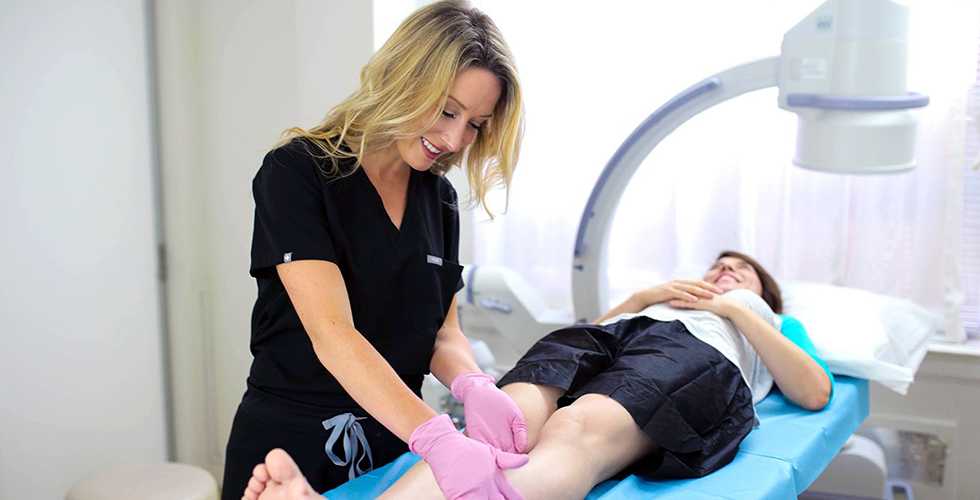How can you identify varicose veins?
If you’re concerned about the appearance of your legs or have pain or other symptoms, you may wonder if you have varicose veins. Here’s a look at how to identify varicose veins and what you can do about them.
What are varicose veins?
Varicose veins are enlarged veins that can be blue, red, or flesh-colored. They often look like cords and can appear twisted and bulging. They can occur anywhere in the body but are most common in the legs. This is because standing and walking upright puts extra pressure on the veins in your lower body.
What are the symptoms of varicose veins?
In addition to the visible signs of varicose veins, you may also experience the following:
- Aching or pain in your legs
- Heaviness or fatigue in your legs
- Ankle swelling
- Itchy skin over the affected area
- Restless legs
- Burning or throbbing in your legs
- Muscle cramping
- Bleeding from varicose veins

When should I see a vein doctor?
If you have any of the symptoms listed above, or you’re concerned about the appearance of your veins, make an appointment to see your vein doctor. The vein doctor can perform a physical examination and may order additional ultrasound tests to confirm the diagnosis.
Maryland Vein Clinics is led by board-certified vein doctors who diagnose and treat the root cause of varicose veins — not just the symptoms. Our vein doctors specialize in minimally invasive varicose vein treatments, such as endovenous laser ablation, sclerotherapy, and ambulatory phlebectomy. These procedures conclude within an hour and allow you to resume your daily activities and work immediately — with no downtime.
If you’re in or around the Beltway, you can find our vein clinic at 10215 Fernwood Rd, Suite 301, Bethesda, Maryland. Please schedule an appointment with our board-certified vein doctors if you notice the signs and symptoms of varicose veins.
What’s the difference between varicose veins and spider veins?
There are two types of problematic veins: varicose veins and spider veins. Both are enlarged and twisted veins, but there are some key differences between the two.
- Varicose veins are generally larger in size than spider veins. They can become quite large and are often blue or purple in color. They also bulge out of the skin’s surface. Spider veins, however, are much smaller and remain under the skin’s surface.
- Varicose veins can cause a lot of pain and discomfort. They can make your legs feel heavy and tired and even cause cramping. Spider veins, while not as uncomfortable, can still cause some pain and swelling.
- Varicose veins are found on the legs and lower extremities of the body. Spider veins are also most commonly found on the legs but can also be seen on the face and chest.
- Varicose veins are a more serious problem than spider veins. They can lead to deep vein thrombosis, blood clots, and other serious health problems. Spider veins are unsightly and, in some cases, also caused by underlying vein disease, but they’re not always dangerous.
What causes varicose veins?
The root cause of varicose veins is chronic venous insufficiency, a medical condition wherein the collapse of vein valves leads to the accumulation of blood in leg veins. The vein valves in your leg veins allow blood to flow up towards your heart against the force of gravity. When your vein valves collapse or malfunction, blood flows backward and accumulates in the leg veins, eventually leading to vascular dilation and the formation of spider veins and varicose veins.
Chronic venous insufficiency is the root cause of varicose veins. But numerous factors can contribute to weakened or damaged vein valves, paving the way for varicose veins, including:
- Age: As you age, your veins may lose elasticity and cause vein disease.
- Pregnancy: The increased blood volume and weight gain that comes with pregnancy can put added pressure on your veins, leading to vein disease and varicose veins.
- Obesity: Being overweight can also lead to added pressure on your veins.
- Heredity: If varicose veins run in your family, you may be more likely to develop them.
- Prolonged sitting or standing: This can cause blood to pool in your veins, leading to dilated blood vessels and varicose veins.
What are the signs and symptoms of vein disease?
Vein disease is a condition that occurs when the veins in your body become damaged or blocked. Vein disease can lead to serious health problems, including blood clots, leg ulcers, and skin infections. If you have any of the following symptoms, you should see a vein doctor as soon as possible:
- Swelling in your legs or feet
- Pain or cramping in your legs
- Aching or heaviness in your legs
- Itching or burning sensation in your legs
- Restless legs syndrome
- Spider veins or varicose veins
What happens if varicose veins are left untreated?
There are a few potential complications of untreated vein disease, the most serious of which is deep vein thrombosis (DVT). This is when a blood clot forms in the deeper veins of your body, usually in the leg. If the clot breaks free and travels to the lungs, it can cause a pulmonary embolism, which can be fatal.
Other potential complications of untreated varicose veins include:
- Skin ulcers: Over time, the skin around the varicose veins can break down and form ulcers.
- Bleeding: Varicose veins can sometimes bleed profusely, especially if you injure them.
- Infection: If the skin around the varicose veins breaks down, there’s a risk of infection.






